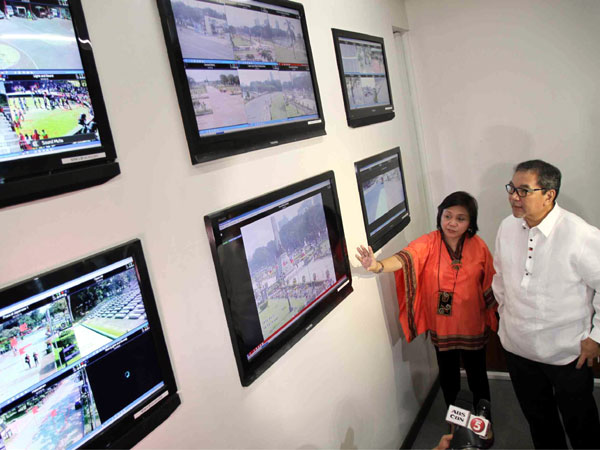
Someone is watching you. Look up—a little over to the left or right. On street corners and doorways. Sometimes from lampposts and walls. See those innocent-looking boxes, that glint of glass? They are closed circuit television (CCTV) cameras and they are everywhere.
You might describe them as the latest incarnation of secret marshals, undercover cops on the prowl for felons and miscreants. And indeed, they’re everywhere because crime is everywhere. No less than President Aquino has expressed alarm over the recent spate of armed robberies and high-profile crimes in Metro Manila, prompting government agencies, businesses and even plain citizens to deploy this latest version of Big Brother throughout the city.
The main use of CCTV is to deter crime and improve personal security, said Chief Superintendent Leonardo Espina, director of the National Capital Region Police Office (NCRPO). Espina said that the Philippine National Police is “very much in favor” of encouraging businesses and homes to install their own CCTV cameras.
“A security camera is a very helpful tool in crime prevention and its footage can be used as evidence in ’after-the-fact’ investigation,” Espina explained. “It can preempt or discourage someone with criminal intent to push through with the act when he knows he is being watched,” the NCR police chief added.
In Quezon City, the local council now requires stores and companies with at least P1-million capitalization to install CCTV cameras as part of requirements in renewing business permits and licenses. On the priority list are banks, malls, supermarkets, schools, pawnshops, gasoline stations, convenience stores and other financial institutions.
The “No CCTV, No Business Permit” policy started this year, according to (ret.) Gen. Elmo San Diego, the city public order and safety chief. San Diego said the city’s Department of Public Order and Safety (DPOS) has released the guidelines and technical specifications of CCTV cameras which are crucial in effective monitoring. Shop owners are given 90 days to comply with the ordinance, or their stores would be shut down.
“The CCTV’s technical specifications and screen resolution are important, and it’s not just for the sake of compliance. Some storeowners might put one up, masabi lang na there’s CCTV,” San Diego said.
While business owners have expressed concerns about additional costs, the public order and safety chief underscored the value of security in any business setting. “It’s for our safety,” he said, and yes, “sari-sari (small variety) stores are exempted,” San Diego added.
The Quezon City Hall itself is set to install its own CCTV system next year, to complement the 130 cameras worth P100 million that will be installed in the 142 barangays of the city. The target areas include the busy streets of Quezon Avenue, Elliptical Road, Commonwealth Avenue, Visayas Avenue, Mindanao, North Avenue and East Avenue. The command center is set to be housed in the DPOS building that will be built this year.
While other cities are considering a similar security plan, the question of privacy has been raised by some. But San Diego brushed this concern aside. “The public’s safety is our priority. We are not here to set up cameras in your bedroom or living room,” he said.
The NCR police chief knows the value of that extra eye in public spaces. Should criminal acts be caught on camera, the monitoring team can immediately inform authorities who can then act accordingly, Espina said. He added that video footage from CCTV cameras have also been used to identify suspects and even solve cases.
A footage of the recent mall heist of the so-called “Martilyo Gang” shows that five of the six robbers were caught on video. The video shows how two of the men bought wrenches from a hardware store in the mall, and used these tools to break the glass cases of the two jewelry stores that they had targeted. Using the footage as a guide, the mall management and the police studied the criminals’ modus operandi, and have since implemented stricter rules, including the deployment of additional guards to prevent similar crimes.

In other cases, CCTV cameras have served as silent but precise witnesses.
In the George Anikow murder case, a security video near an upscale subdivision captured how the US Marine officer was beaten up and stabbed repeatedly by a group of young men. The footage was eventually used as evidence against the suspects-Juan Alfonso Abastillas, Crispin de la Paz, Osric Cabrera and Galicano Datu III.
Anikow was stabbed to death on Nov. 24 last year by the four young men near Rockwell in Makati City, after the reportedly drunk American tapped the group’s vehicle and joined the subdivision guard in asking the men to show their IDs at the gate. The act allegedly provoked the suspects who then ganged up on the American.
“It’s a strong case. The video footage showed who did it. Kitang-kita-pak-all in a split second,” Espina said.
A surveillance camera was also instrumental in the investigation of the Kelvin Tan murder case that happened in Greenhills on Jan 29. Tan, a contractor and owner of KT Builders Inc., was shot dead inside his vehicle by an unidentified gunman on Madison Street.
According to police reports, Tan had just cashed a check worth P800,000 at the bank before he was killed. Several witnesses said the victim handed it over to a man later identified as Reggie Guadayo before he was shot.
The San Juan City police filed a case against Guadayo, who denied the allegation. Police are now looking for five other suspects based on the images caught by a CCTV near the bank.
Aside from being a crime deterrent, Espina said CCTV cameras are useful for crowd control. The PNP installed several CCTV cameras along the route of the Black Nazarene during its feast in January. The cameras monitored the traffic and allowed for a tighter view of the more than a million devotees in real time.
“We were able to make on-the-spot decisions that resulted in the least number of injuries and adjustments in crowd control,” the police officer said.
Even netizens can benefit from the CCTV cameras of government agencies through their Twitter accounts and other social media networks. Among these agencies is the Metropolitan Manila Development Authority (MMDA), which provides real-time traffic updates on eight national roads including Edsa, allowing Twitter users to know which roads to avoid and which routes to use.
The MMDA also launched its mobile metrobase to monitor floods and other disasters through a van equipped with five TV screens, a microwave antenna, and a camera capable of a 360-degree view. Three screens show feeds from major TV stations, while one is linked to MMDA’s CCTV cameras from the main command center. Another screen is used for a traffic navigator system.
For Rizal Park’s official caretakers, the video cameras serve a special purpose. The CCTV cameras are best used to help parents look for their lost kids and call the attention of overly affectionate lovers, according to Kenneth Montegrande, the spokesperson of the National Parks Development Committee (NPDC).
“Out of thousands of visitors in a day, we help parents look for their kids who may have lost their way in the children’s park. We also politely discourage public displays of affection by lovers,” Montegrande said.
“We’re aware that the Chinese Garden is a romantic place and is considered a lovers’ park, but this is not a venue for love-making. Let’s respect the park and the history the place holds. Delicadeza na lang, di ba?” he said.
Security remains the top concern especially during such big celebrations as the New Year’s Eve countdown, when the park hosts up to 1.5 million people, based on the NPDC records. To monitor such a huge crowd, the NPDC acquired one of the country’s most advanced CCTV systems which consists of 12 fixed and 14 360-degree rotating cameras that can magnify the subject up to 30 times-close enough to find out the identity of a snatcher or that over-amorous park goer.
Aside from its telescopic lens, the CCTV system also has the capability to differentiate a person from a vehicle, record the crowd count, and recognize the faces of fugitives based on the databases of the National Bureau of Investigation. “The CCTV cameras are very useful for our security and maintenance functions, and help us monitor our own employees who may be sleeping on the job. Some might think those trees make for good hiding nooks, but surveillance cameras placed in strategic areas can detect those now,” the park official said.
“Development should be coupled with peace and order. No matter how beautiful you develop your park, people won’t come if it’s not safe,” Montegrande said. The park used to be a vagrant’s haven, with snatchers from nearby avenues blending in with the crowd or turning the park into a getaway shortcut. But the park has undergone major reforms in the last three years to change such mindset among criminal elements, he added.
“The homeless have been identified and given jobs as park maintenance crew. We provided them with the means to earn and rent their own place,” he said.
The NDCP and PNP also recorded a zero-crime rate in the park’s biggest event—the New Year’s Eve countdown for two consecutive years, said Montegrande. “With more guards and CCTV, bad elements are discouraged from preying on innocent park goers.”
Even some Catholic churches in Quezon City have become security conscious and are setting up CCTV systems. The Diocese of Cubao under Bishop Honesto Ongtioco sees the cameras as a deterrent to thieves who prey on the faithful or steal antique religious artifacts and icons.
Whether it’s holy ground, public space or private turf, Espina is keen on crime prevention. “According to our legal experts, [the video that recorded the actual act of crime] may be considered private property, but with the consent of the owners, we can use it in court as evidence,” he said.
Major television networks have recognized as well the visual impact of raw camera footage in reporting crime news. ABS-CBN has a dedicated segment of CCTV-based reporting called “CCTV Patrol,” while its biggest rival, GMA 7 has its counterpart called “Hulicam” and a segment called “YouScoop” using crowd-sourced photo stills and video footage.
Homeowners have also become security conscious and are increasingly turning to CCTV cameras for help, especially since the system can be set up without robbing a bank.
A complete set costs from P8,000 to P15,000, while those with more sophisticated features are offered starting at P20,000.
The best security system, however, is a judicious combination of caution, preparedness and prevention. In the end, the CCTV is just one method to see you through. •









































